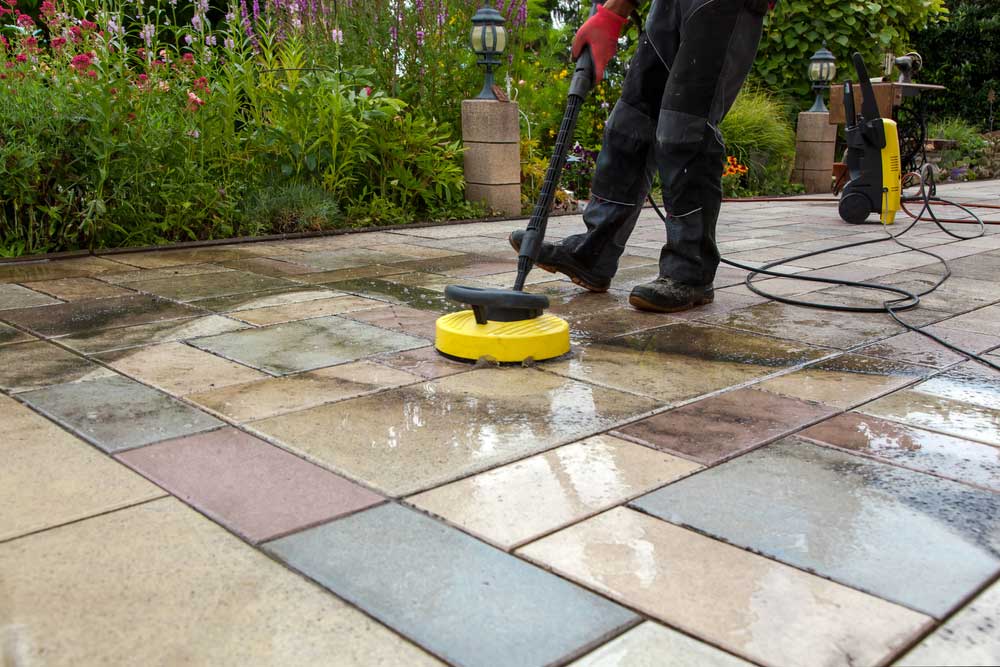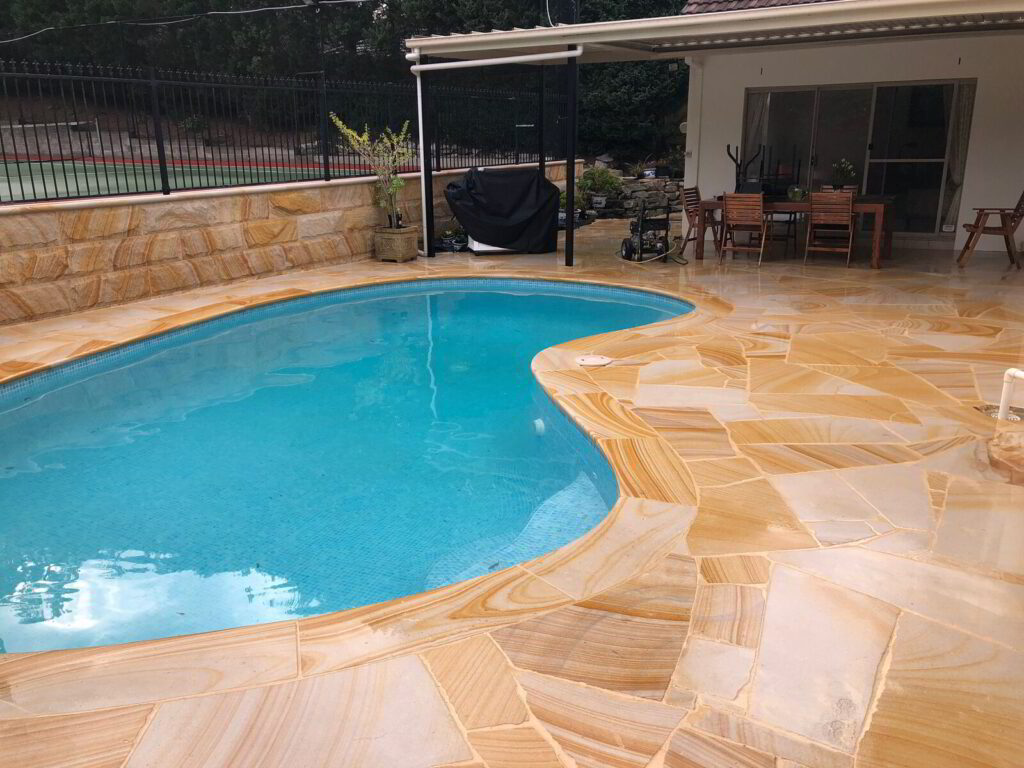You’ve got stunning sandstone features in your home, and you’re ready to keep them looking their best. Fear not; we’ve got you covered.
This guide will walk you through the dos and don’ts of sandstone care. You’ll learn how to clean and tackle stubborn stains and even get tips on preventive maintenance.
From everyday dish soap to avoiding harmful acids, we’ll help you keep your sandstone as beautiful as the day you bought it.
Key Takeaways
- Keep your sandstone clean with regular sweeping and damp wiping, and avoid cleaners not labeled for natural stones.
- Tackle tough stains with specific cleaning solutions – use a baking soda poultice for oil-based stains, hydrogen peroxide, or a stone-safe cleaner for organic stains.
- For cleaning and maintaining Australian sandstone, use a specific once-a-year method involving diluted pool chlorine, careful application, and thorough rinsing.
- Prevent staining and prolong your sandstone’s life with regular use of a high-quality, oil-resistant sealant.
- When in doubt, especially when dealing with sealants, it is recommended to call in professionals to ensure the best care for your sandstone.
General Steps to Cleaning Sandstone Pavers and Natural Stone
1. To kick off with the general cleaning techniques for sandstone, use a broom to sweep off any loose dirt and debris from the surface of your sandstone. This initial step is simple, but it’s crucial as it prevents scratching of the floor or surface of the sandstone when you begin the cleaning process.
2. Next, use a dry towel or a soft brush to remove crumbs and dust.
3. Then, vacuum the surface to ensure you’ve got rid of all loose dirt and debris.
4. After that, gently wipe down the surface with a damp cloth or a soft floor-cleaning mop. Stick to cleaning products specifically designed for natural stones to keep your sandstone looking its best.

Avoiding Acidic Sandstone Cleaners
Acidic solutions can etch the surface, permanently changing the stone’s texture and color. This includes cleaners with citrus or vinegar, which might seem harmless but can be quite damaging.
Instead, look for products specifically designed for natural stones. These cleaners are gentle yet effective, preserving the integrity of your sandstone.
And remember, simple is often best. Often, all you need is a little water and a soft cloth to keep your stone in pristine condition.
Using Dish Soap to Properly Clean Sandstone
If you find that water alone isn’t doing the trick, you can gently clean your sandstone with a bit of plain dish soap. Dish soap is a mild cleaner that’s likely already in your kitchen, making it a convenient choice.
Here’s a simple, 4-step method:
- Dampen a cloth with warm water. Make sure it’s not dripping wet.
- Add a few drops of plain dish soap to the cloth.
- Gently clean the sandstone surface, making sure not to scrub too hard.
- Rinse the area with clean water. Afterward, thoroughly dry the sandstone to avoid water marks or potential damage.
Tackling Tough Interior and Exterior Stains
When it comes to tougher interior and exterior stains on your sandstone, it’s essential to identify what type of stain you’re dealing with. Certain cleaners work best for specific stains.
Here are some quick tips on how to use appropriate cleaners for various stain types.
- Oil-based stains: These leave a dark discoloration on your stone. Use a poultice made of baking soda and water to combat these.
- Organic stains: Caused by coffee, tea, or fruit, these stains can be removed with hydrogen peroxide or a stone-safe stain remover.
- Ink stains: These can be cleaned with a poultice made from rubbing alcohol.
- Metal stains: Rust or copper stains require a specific stone stain remover.
Oil-Based Stain Removal
If you’re dealing with an oil-based stain on your sandstone, a simple solution is using a baking soda poultice. Here’s a step-by-step guide:
- Create a mixture of baking soda and water. Aim for a paste-like consistency that’s thick enough to stick to the stone.
- Apply the poultice directly onto the stain. Make sure it completely covers the stained area.
- Let the poultice sit on the stain for 24 hours. This gives it time to absorb the oil.
- After 24 hours, gently remove the poultice using a soft brush or cloth and rinse with water.
Preventing Oil Stains
To keep your sandstone looking its best, it’s important to prevent oil stains before they happen. There’s a simple way to do this.
Start by applying a high-quality, oil-resistant sealant to your sandstone. This creates a barrier that repels oil, making it easier to wipe up spills before they seep in.
For daily prevention, promptly clean up any oil spills to minimize absorption.
Organic Stain Removal Techniques
When tackling organic stains on your sandstone, you’ll need to choose an effective, stone-safe stain remover. Organic stains can be tricky, so here’s a handy guide:
- Consider using hydrogen peroxide. This is a safe and effective option for tackling organic stains; just be sure to dilute it with water before applying.
- Try baking soda. It’s an excellent natural cleaner. Make a paste with water and apply it to the stain.
- Use a stone-safe stain remover. These are specially formulated to be gentle on stone while still powerful against stains.
- Always test first. Before applying any product to a larger area, test it on a small, inconspicuous spot to ensure it won’t discolor or damage the sandstone.
Applying Hydrogen Peroxide Safely
If you’ve decided to use hydrogen peroxide to tackle those stubborn organic stains on your sandstone and give it a deep clean, it’s important to apply it safely to avoid causing any damage.
1. Start by donning protective gloves and eyewear.
2. Then, dilute the hydrogen peroxide in water using a 1:1 ratio.
3. Apply this solution to the stained area using a soft cloth or sponge, but don’t let it sit for more than a few minutes.
4. Rinse thoroughly with clean water afterward.
Hydrogen peroxide can lighten the color of your sandstone, so be sure to test this method on a hidden area first.
With careful use, hydrogen peroxide can help you restore the natural beauty of your sandstone without resorting to harsh chemical cleaners.
Additional Steps For Cleaning Australian Sandstone Using Chlorine

Here is a simple three-step method that you can do once a year.
Step 1: Make your cleaning mix. In a spray bottle, combine one part of liquid pool chlorine with nine parts of water.
Step 2: Spray this mix onto your sandstone. This could be your pavers, tiles, or any sandstone surface.
Step 3: Wait for one hour, then rinse off the mix with clean water.
Use a hose with a standard pressure nozzle for easy rinsing. If there are stubborn stains, a soft brush will help remove them.
If the sandstone isn’t as clean as you’d like, repeat the process. Or, you can try a stronger chlorine and water mix.
Remember, this cleaning method is best for unsealed Australian sandstone. If your sandstone is sealed or oxidized, you may need a different method.
Conclusion: Preventive Maintenance for Sandstone
To keep your sandstone in top shape, you’ll need to carry out regular preventive maintenance. This not only enhances the stone’s appearance but also elongates its life.
Here are three simple steps you can follow:
- Regularly sweep and clean the surface to prevent the buildup of dirt and grime. A soft brush is best for this.
- Avoid harsh cleaners. Abrasive cleaners or scrub brushes can scratch and damage the stone. Stick to cleaners specifically designed for sandstone.
- Act quickly. Wipe up spills immediately to prevent staining. Remember, the longer a stain sits, the more difficult it will be to remove.
Additionally, you can protect your sandstone from stains and damage by applying a sealant. This should be done periodically and more frequently in high-traffic areas.
Steer clear of surface sealants and opt for deep-penetrating sealants instead. These types let your stone breathe better. Don’t fall for cheap sealants from typical hardware stores – they may not last long or could alter your stone’s appearance.
If you’re considering trying an enhancing or “wet-look” sealant, it’s smart to first test it on a few small areas of your stone.
Doing the cleaning and sealing work yourself can be a challenge, especially when dealing with sealants. Because of this, it’s usually a good idea to enlist the help of professional sandstone cleaners or sealers.
Their expertise ensures a well-done job and leaves your sandstone looking its best for longer. If you need advice or help with sealing your sandstone, just reach out to Stone Protection.
FAQ
How do you clean natural sandstone?
For natural sandstone, regular cleaning is recommended using a diluted mix of mild alkaline detergent and warm water, applied via a gentle brush. Sandstone is porous; hence, quick and regular cleaning helps avoid the absorption of dirt.
How do you clean sandstone stone?
Cleaning sandstone stone requires a non-abrasive approach due to its porous nature. Using a mild soap or specially designed stone cleaner with a soft bristle brush can effectively clean the stone without causing any damage.
Can you use vinegar to clean sandstone?
Vinegar, due to its acidic nature, is not recommended for cleaning sandstone as it may damage the surface. Instead, use a mild alkaline cleaning solution or gentle detergents for more favorable results.
Can I pressure wash sandstone?
While pressure washing can be used to clean sandstone, it should be done at a low setting. High-pressure washing may cause damage to the surface due to the stone’s porous nature.
How do you clean untreated sandstone?
Untreated sandstone can be cleaned using a soft bristle brush and mild detergent solution. For stubborn stains, spot clean with a mild bleach solution, taking care not to use too much as this can damage the material. Address issues of moss and mould as needed.





